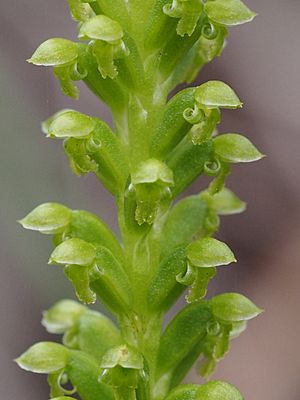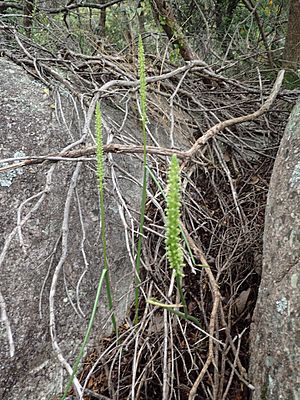Common mignonette orchid facts for kids
Quick facts for kids Common mignonette orchid |
|
|---|---|
 |
|
| Part of the flowering stem of Microtis media | |
| Scientific classification | |
| Genus: |
Microtis (plant)
|
| Species: |
media
|
| Subspecies | |

The Microtis media, often called the common mignonette orchid, is a special type of plant. It belongs to the orchid family and grows only in the south-west part of Western Australia. This orchid has a single, long leaf that looks like a tube. It also has many small, yellowish-green flowers. These flowers grow along a tall stem.
Contents
What it Looks Like
The common mignonette orchid is a deciduous plant. This means its leaves fall off at certain times of the year. It grows from a special underground part called a tuber. Each plant has one leaf that looks like a tube. This leaf can be about 25 to 65 centimeters long. It wraps around the bottom part of the flower stem.
The flowers are green and small, about 2.5 to 3 millimeters wide. They grow around a straight stem that can be 20 to 60 centimeters tall. The top sepal (a part of the flower) forms a hood over the column. The petals face forward. The side sepals are curled. The labellum (a special lip-like petal) is thick. It has a rough, uneven edge and a raised part called a callus.
Naming the Orchid
The common mignonette orchid was first officially described in 1810. A scientist named Robert Brown wrote about it. He found a sample of the plant in 1801 at King George Sound. His description was published in a book called Prodromus Florae Novae Hollandiae et Insulae Van Diemen.
The second part of its scientific name, media, is a Latin word. It means "medium" or "middle." This name refers to how the flower looks, being in between other similar orchids.
In 1825, this plant was shown in a famous book called Curtis's Botanical Magazine. It was given the common name "middle-sized microtis." A botanist named Allan Cunningham noted that the plant used for the picture grew from soil collected by Phillip Parker King.
Different Types of Microtis media
In 1990, a scientist named Robert John Bates described two main types, or subspecies, of Microtis media. These names are now accepted by plant experts:
- Microtis media subsp. media: This type has a labellum with a rough, uneven edge. It also has a clear, raised callus.
- Microtis media subsp. densiflora: This type has a labellum that is almost smooth. Its labellum callus is smaller.
Some other types that were once considered subspecies of Microtis media are now seen as their own separate species. These include Microtis eremicola and Microtis quadrata.
Where it Grows
The common mignonette orchid grows in different kinds of places. You can find it in shrubland, woodland, and forests. It often grows in areas that are wet during certain times of the year. It also likes to grow on granite rock formations. This orchid is found in the south-west of Western Australia. Its range stretches from Shark Bay all the way to Eyre.
How it is Protected
The Western Australian Government's Department of Parks and Wildlife has looked at this orchid. They have classified it as "not threatened." This means it is not currently in danger of disappearing.

